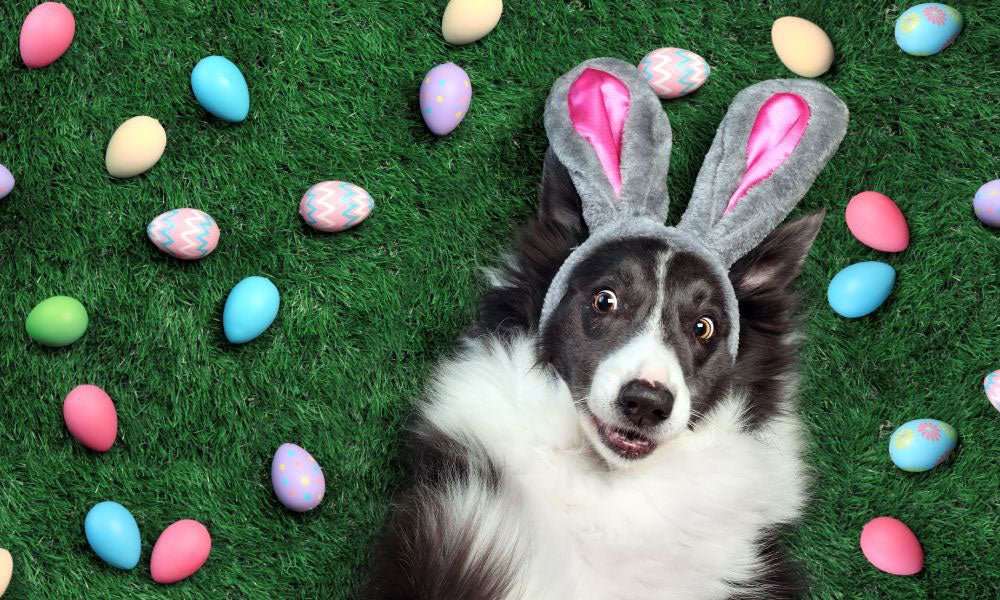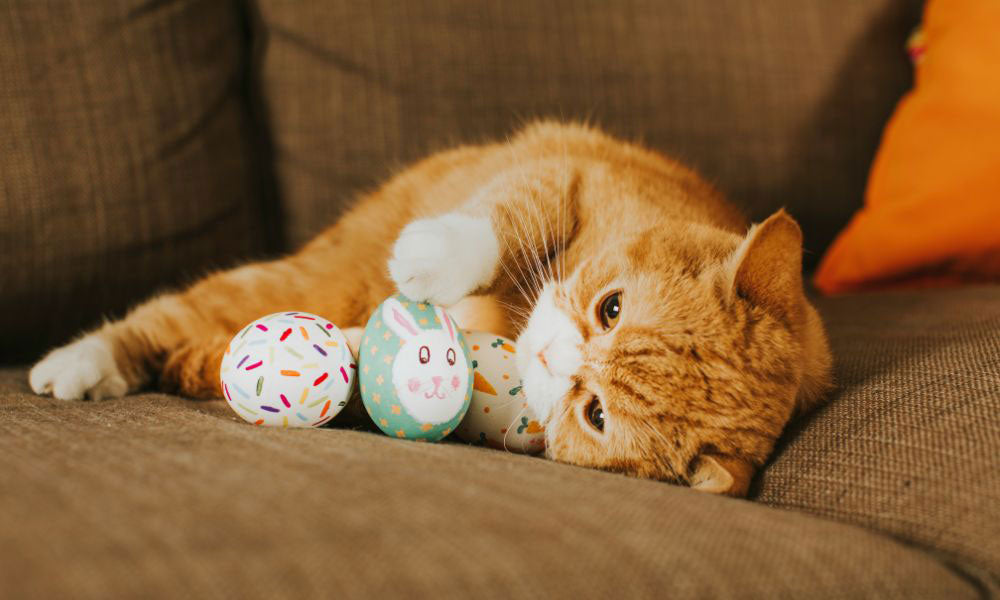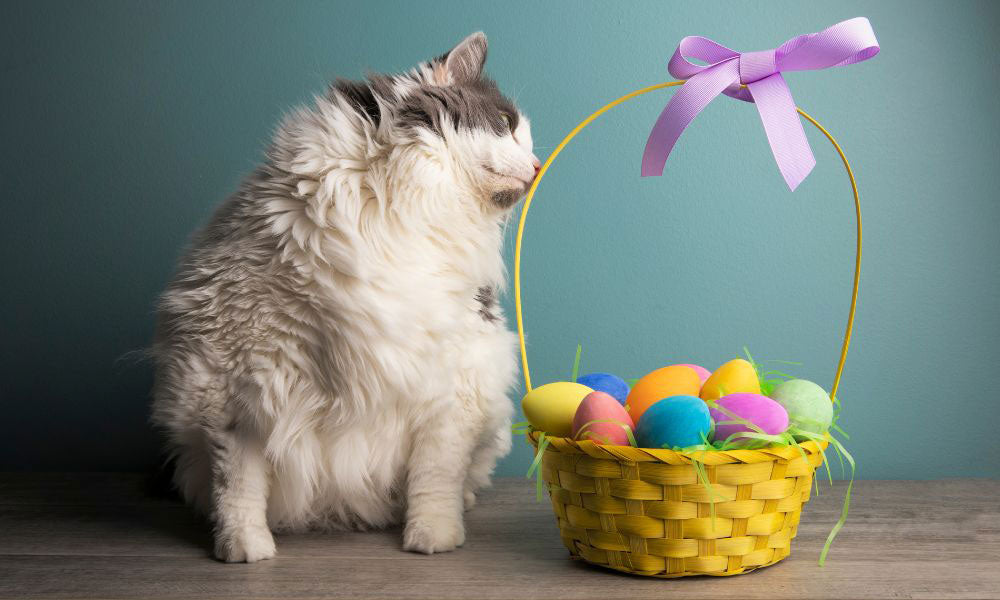
Have a Happy Easter with your pets
Easter is a time of joy and celebration for many families, which for many of us, includes our furry family members too. However, amidst the seasonal celebrations and get togethers, it's crucial to remember the safety and happiness of our beloved pets. From potential hazards to fun activities, this week, we've come up with a comprehensive guide to ensure that you all have a wonderful Easter together.
 Photo Credit: Canva
Photo Credit: Canva
Easter food and drink hazards for pets to avoid
Easter can bring several hazards for pets, so it's important to be vigilant. Here are some common hazards to watch out for:
- Chocolate: Chocolate contains theobromine and caffeine, which are toxic to pets, especially dogs and cats. Dark chocolate and cocoa powder are particularly dangerous due to their higher levels of theobromine.
- Easter Treats: Sweets and easter eggs, especially those with wrappers or foil, can pose a choking hazard or cause intestinal blockages if ingested by pets. If chocolate has melted onto a wrapper then they may be tempted to simply eat that so make sure that everything goes in the bin!
- Table Scraps: Rich, fatty foods commonly served during Easter dinners can cause pancreatitis in pets. Additionally, bones from cooked meats can splinter and cause gastrointestinal injuries.
- Alcohol: Alcoholic beverages may be present at Easter gatherings, and even small amounts can cause intoxication, vomiting, diarrhoea, difficulty breathing, tremors, coma, and death in pets.
- Easter egg dye: Chemicals used to dye Easter eggs can be toxic if ingested by pets. If you’re creating dyed boiled eggs or eggshells, be sure to keep dyeing materials out of reach and clean up spills promptly.
- Easter egg hunts: If you’re hiding foil wrapped eggs items or chocolate make sure that your pet doesn’t find them first! Some dogs will happily eat chocolate with the wrapper on so make sure that you don’t leave any within reach and if you’re planning an easter egg hunt in your home or garden, make a note of where everything is in case come are missed and your pet finds them and eats them sometime down the line!
- Easter biscuits and hot cross buns: Hot cross buns contain raisins currants and cinnamon, all of which are toxic to dogs so make sure you don’t drop any crumbs or leave them unattended.
 Photo Credit: Canva
Photo Credit: Canva
Surviving an Easter emergency for your pet
If your pet ingests chocolate or Easter treats, it's essential to take immediate action to prevent any potential health complications. Here's what you should do:
-
Assess the Situation
Determine the type and amount of chocolate or treats your pet has ingested. This information will be helpful for your veterinarian in assessing the severity of the situation. How much did they eat? When did they eat it, was the wrapper still on it?
-
Contact Your Vet
Although your vet will most likely be closed over the bank holiday weekend, they should have an emergency service available or they will be able to driect you to a vet that does. Call your them right away and provide them with details about your pet's size, weight, the type of chocolate or treats consumed, and the estimated amount ingested. Follow their instructions carefully. -
Monitor for Symptoms
Keep a close eye on your pet for any signs of chocolate toxicity, which can include vomiting, diarrhoea, increased thirst and urination, restlessness, panting, rapid breathing, muscle tremors, seizures, and in severe cases, collapse or death. The onset and severity of symptoms can vary depending on factors such as the type of food, the amount eaten, and your pet's size and sensitivity. -
Follow Veterinary Guidance
Your vet may recommend bringing your pet in for evaluation and treatment. Treatment may involve supportive care such as intravenous fluids, activated charcoal to absorb toxins, medication to control symptoms, and monitoring for any complications. -
Prevent Future Incidents
Take steps to prevent your pet from accessing chocolate or other toxic treats in the future. Keep all Easter treats, sweets, and chocolates securely stored in cabinets or high shelves where pets cannot reach them. Educate family members and guests about the importance of keeping these items out of your pet's reach. -
Stay Calm
Whilst it's natural to feel worried or anxious when your pet ingests something harmful, try to stay calm and focused. Taking swift action and following veterinary guidance can help minimize the potential risks and ensure the best possible outcome for your pet.
By acting quickly and seeking veterinary care, you can help ensure the safety and well-being of your pet if they eat chocolate or any other Easter treats.
 Photo Credit: Canva
Photo Credit: Canva
Easter decoration hazards for pets
Easter decorations can also pose various hazards to pets if they are ingested or played with inappropriately. Here are some common hazards associated with Easter decorations:
- Choking or ingestion: Decorative items such as painted, foil or plastic eggs, ribbons, bows, small toys, fluffy chicks and decorative grass can be tempting for pets to chew on or play with. If ingested, these items can cause choking, gastrointestinal obstructions, or intestinal perforations, which may require surgical intervention.
- Toxic materials: Some Easter decorations may contain toxic substances or materials that are harmful to pets if ingested. For example, the artificial grass used in Easter baskets can be made from materials that are not safe for pets if swallowed. Additionally, certain paints, glues, or dyes used in decorations may contain toxic chemicals that can cause poisoning if ingested.
- Electrical hazards: Easter decorations such as string lights or electrical ornaments can pose a risk of electrical shock or burns if pets chew on cords or come into contact with exposed wires. Make sure to secure electrical cords and keep them out of your pet's reach to prevent accidents.
- Fragile decorations: Delicate or fragile Easter decorations such as glass ornaments or figurines can easily break if knocked over or pawed at by pets. Broken pieces can cause cuts, lacerations, or injuries to your pet's mouth, paws, or digestive tract if ingested.
- Decorative plants: Some Easter decorations may include live plants or flowers that are toxic to pets if ingested. For example, Easter lilies are highly toxic to cats and can cause kidney failure if ingested even in small amounts. Other common toxic plants include tulips, daffodils, and hyacinths.
 Tulip cat photo by Dieu Mien on Pexels
Tulip cat photo by Dieu Mien on Pexels
Coping with an influx of Easter visitors
Some pets just aren’t particularly sociable or can become overwhelmed with differences from the ‘norm’ in your home environment. Helping your dog or cat cope with an influx of Easter visitors requires careful planning and consideration of your pet's needs. Here are some tips to help your furry friend feel more comfortable during any festivities.
- Create a safe space: Set up a quiet, comfortable area where your pet can retreat to if they feel overwhelmed by the presence of visitors. This could be a separate room or a cosy corner with their bed, favourite toys, and water bowl. Make sure this space is off-limits to guests to provide your pet with a sense of security and privacy.
- Introduce visitors slowly: If your pet is not accustomed to a lot of people, gradually introduce them to visitors in a calm and controlled manner. Allow your pet to approach guests on their own terms and provide positive reinforcement, such as treats or praise, for calm behaviour.
- Use calming techniques: If your pet is particularly, anxious, consider using calming aids, such as pheromone diffusers, calming sprays, or anxiety vests, to help alleviate your pet's stress during the influx of visitors. You can also play soothing music or white noise to create a calming environment.
- Maintain routine: Stick to your pet's regular feeding, exercise, and bedtime routine as much as possible during Easter gatherings. Maintaining a familiar schedule can help reduce your pet's anxiety and provide them with a sense of stability amidst the hustle and bustle of visitors.
- Provide distractions: Keep your pet occupied with interactive toys, puzzle feeders, or long-lasting chews to help distract them and alleviate boredom during Easter gatherings. Engaging your pet in mentally stimulating activities can also help reduce their stress and anxiety.
- Supervise interactions: Supervise interactions between your pet and visitors, especially children, to ensure that they are safe and comfortable. Teach children how to approach and interact with pets gently and respectfully, and monitor their behaviour around your pet at all times.
- Brief your guests on how to interact: Let your guests know how to approach your pet and make sure they are aware of any potential hazards posed by certain easter foods, discarded wrappers, etc.
 Spring dog photo by Cheryl Prince on Pexels
Spring dog photo by Cheryl Prince on Pexels
To prevent accidents and keep your pet safe during Easter celebrations, it's essential to pet-proof your home by removing or securing any potential hazards. Keep decorations out of your pet's reach, supervise them closely around festive displays, and educate guests about the importance of keeping toxic items away from pets. If you suspect that your pet has ingested something harmful or is experiencing symptoms of poisoning, contact your veterinarian immediately for assistance.
Fun Easter activities for pets
Now we’ve talked all about some of the dangers and problems for your pets at Easter, we mustn’t forget that Easter can be a fun time for them too! Here are some enjoyable Easter activities you can do together.
-
Easter egg hunt
Hide pet-friendly treats or toys around your garden or home and encourage your pet to sniff them out. You can use plastic eggs or simply hide treats in various locations. It's a great way to engage their natural scavenging instincts and provide mental stimulation. -
Easter photo shoot
Snap your pet with some Easter accessories and capture some memorable photos. You can use props like Easter baskets, eggs, or bunting to add a festive touch. Share the photos on social media or create a special Easter photo album. -
DIY Easter toys
Get creative and make homemade Easter toys for your pets. You can create simple toys using materials like cardboard tubes, fabric scraps, or old socks. Fill them with treats or catnip to make them extra enticing for your pet to play with. - Easter agility course: Set up a mini agility course in your garden or living room using household items like chairs, tunnels, and cones. Guide your pet through the course using treats or toys as motivation. It's a fun way to bond with your pet and keep them active.
-
Easter treat baking
Spend some quality time in the kitchen baking homemade Easter treats for your pet. There are many pet-friendly recipes available online for treats like carrot and peanut butter cookies or bunny-shaped snacks. Just make sure to use ingredients that are safe and healthy for your pet. -
Nature Walk
Take your dog for a scenic nature walk to enjoy the sights and sounds of springtime. Look for signs of new life, such as budding flowers, chirping birds, and buzzing insects. It's a wonderful way to get some exercise and fresh air together.
 Spring walk photo by Krivec Ales on Pexels
Spring walk photo by Krivec Ales on Pexels
Remember to always prioritise your pet's safety and well-being during Easter activities. Supervise them closely, especially during outdoor adventures, and avoid any activities or treats that could pose a risk to their health. With a little creativity and planning, you can make Easter a memorable and enjoyable time for both of you.
 Photo Credit: Canva
Photo Credit: Canva
This Easter, let's ensure our pets are not only safe but also included in the festivities. By being mindful of potential hazards, educating ourselves and our guests, and providing enriching activities, we can make this season enjoyable for every member of the family, including the four-legged ones!
